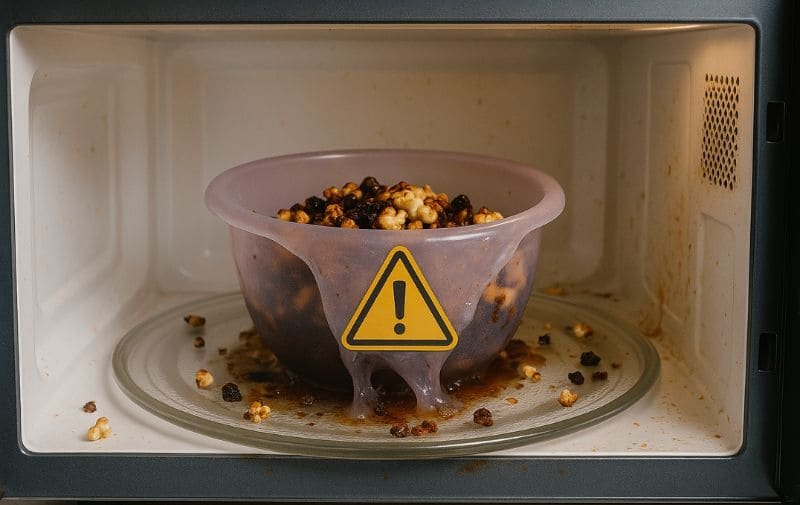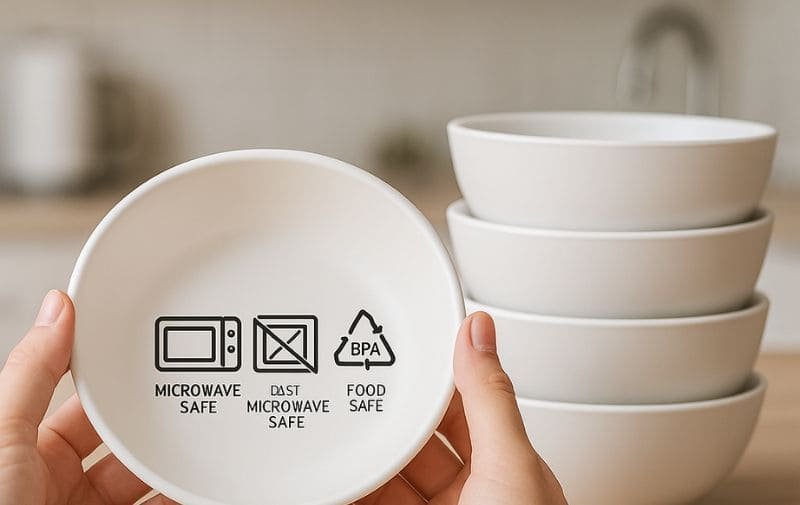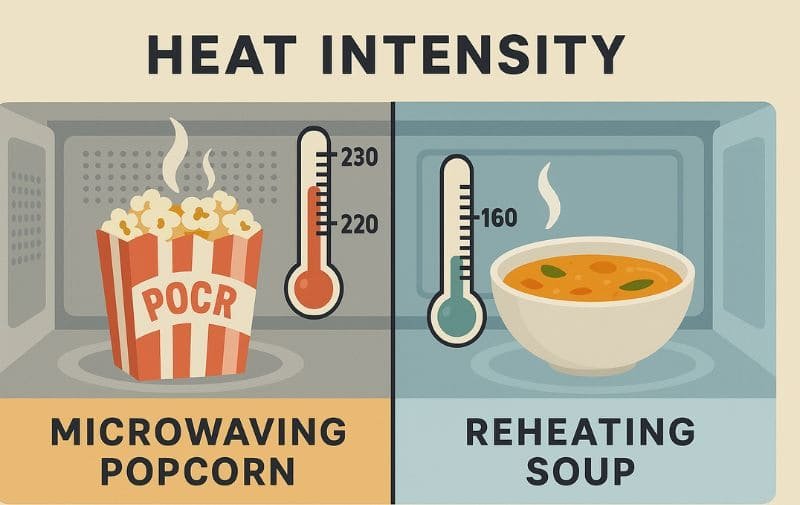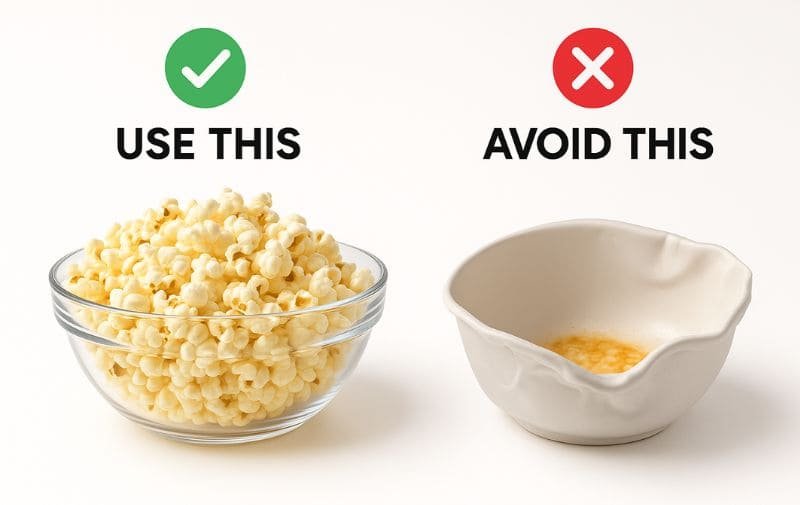You’re craving a quick, warm snack. That plastic bowl seems convenient, but a nagging thought stops you. Is this actually safe?
No, you should never microwave popcorn in a plastic bowl. The intense, focused heat from popping kernels far exceeds the safe temperature for plastics, including “microwave-safe” ones, causing them to potentially warp, melt, and leach harmful chemicals into your food.
Let’s break down exactly what’s happening in your microwave so you can protect your health and choose the right tool for the job.
Last Updated: June 27th. 2025 | Estimated Reading Time: 9 Minutes
The Real Danger: Is Popcorn Heat Different Than Regular Food Heat?
You reheat soup in a plastic bowl all the time, so what’s the big deal with popcorn? Isn’t heat just heat?
Yes, popcorn heat is fundamentally different. Reheating leftovers brings food to water’s boiling point (~100°C / 212°F). Popping popcorn requires super-heated oil and kernels that create intense hotspots reaching 190-200°C (375-400°F), which is high-temperature cooking, not reheating.
This is the single most important concept to grasp, and it’s where almost everyone gets it wrong. When you microwave a bowl of soup, leftovers, or coffee, the microwaves excite the water molecules in the food. The temperature of that food will rise, but it’s generally capped around the boiling point of water: 100°C (212°F). Most “microwave-safe” plastics are designed and tested to withstand this level of wet, gentle heat without breaking down.

Popping popcorn is a completely different thermal event. You are not just reheating; you are actively cooking with dry, intense heat. To make a kernel of corn pop, the small amount of water trapped inside must turn to steam and build up immense pressure. This requires very high temperatures. The kernels themselves, along with any oil you’ve added, create tiny, focused “hot spots” on the surface of the bowl.
These spots can easily reach temperatures of 190-200°C (375-400°F). This is far, far hotter than boiling water and pushes plastic materials well beyond their designed safety limits. You’re essentially putting a tiny, high-temperature frying pan directly onto the plastic surface, which is something it was never meant to handle.
| Heating Method | Target Temperature | Bowl’s Experience | Is It Safe for Plastic? |
|---|---|---|---|
| Reheating Leftovers | ~100°C (212°F) | Even, gentle heating | Yes, if “microwave-safe” |
| Making Popcorn | ~200°C (400°F) | Intense, localized hot spots | No, never |
| Your Home Oven | 175°C – 200°C | Consistent, ambient heat | You wouldn’t put a plastic bowl in the oven; this is the same heat level. |
So What Does “Microwave-Safe” Actually Mean?
But the bowl has the little symbol with the squiggly lines! Doesn’t that mean it’s been approved for this?
The “microwave-safe” symbol certifies that the plastic will not warp or melt under normal reheating conditions. It does not mean the material is safe for high-temperature cooking processes like making popcorn, which generates heat far beyond what the symbol guarantees.

This is a huge point of confusion for consumers, and frankly, a failure in clear communication. When a manufacturer puts a “microwave-safe” symbol on their product, they are certifying it against a specific set of tests. These tests simulate reheating food that contains water, like your leftover pasta. They ensure that under those conditions, the plastic remains stable, doesn’t lose its shape, and doesn’t leach chemicals above a government-regulated safety threshold.
However, these tests do not involve creating super-heated, dry hotspots like those from popping corn. The symbol essentially means “reheat-safe,” not “cook-in-safe.” I always tell people to think of it this way: a “water-resistant” watch can handle you washing your hands, but you wouldn’t take it scuba diving. Similarly, a “microwave-safe” bowl can handle reheating soup, but you shouldn’t ask it to cook popcorn.
You are using the product in a way it was never tested for or intended to be used, which voids any guarantee of safety. The intense, localized heat from a popping kernel is the “scuba diving” for your plastic bowl—a far more extreme condition than it was built for.
Industry Tip: Never trust the “microwave-safe” label for any task that involves “cooking” rather than “reheating” in the microwave. This includes melting butter with sugar, cooking bacon, or popping corn.
A Closer Look at Your Bowl: A Guide to Unsafe Materials
So, what actually happens to your specific bowl? Not all plastics are created equal, but when it comes to microwave popcorn, they all fail in different, dangerous ways.
The Melamine & Bamboo Fiber Rule: A Guaranteed Way to Ruin Your Bowl
As an expert in these materials, I can state this unequivocally: microwaving popcorn in a melamine or bamboo fiber bowl is the single worst thing you can do to it. These are “thermoset” plastics, meaning they don’t melt like other plastics. Instead, the intense heat from the popcorn initiates a chemical breakdown.
Here’s what happens:
- The Resin Dries Out: The heat attacks the resin that binds the bowl together, breaking down its molecular structure. This makes the material permanently brittle and prone to cracking and chipping later.
- The Food-Safe Seal is Destroyed: The glossy, non-porous surface that makes melamine food-safe gets damaged. It develops a “chalky,” rough, or hazy texture. This compromised surface can now harbor bacteria and may leach chemicals into your food, even if you use it for cold cereal weeks later.
- Fillers Get Scorched: In bamboo fiber bowls, the organic bamboo and cornstarch fillers inside the resin can literally scorch from the inside out, further compromising the bowl’s integrity and safety.
You won’t see a melted puddle, but you will have irreversibly ruined the bowl.
| Melamine Bowl Condition | Before Popcorn | After Microwaving Popcorn | What This Means for You |
|---|---|---|---|
| Surface Finish | Glossy, smooth | Chalky, dull, or hazy | The protective food-safe layer is destroyed. |
| Material Integrity | Strong, durable | Brittle, prone to cracks | The bowl is now weak and can break easily. |
| Food Safety | Non-porous, safe | Porous, can harbor bacteria | No longer safe for any food contact. |
The Polypropylene (PP) Gamble: Melting and Pitting
Most of your reusable food containers (like Tupperware or Rubbermaid) are made from Polypropylene (PP, #5 plastic). This is a “thermoplastic,” meaning it melts when heated. PP plastic has a melting point of around 160-170°C (320-340°F).
While this temperature is higher than boiling water, the ~200°C (400°F) hot spots from popcorn kernels and oil can easily exceed it. This causes the plastic on the inside of the bowl to:
- Pit: Tiny white or frosted spots appear where kernels have melted the surface.
- Pucker or Warp: The bowl loses its shape.
- Melt: In extreme cases, the plastic can melt through, creating a hole and potentially fusing to your microwave’s glass plate.
The Single-Use Container Trap: A Definite No
You must never use single-use containers to microwave anything, especially popcorn. Tubs from yogurt, margarine, cottage cheese, or restaurant takeout are typically made from the cheapest plastics possible, designed only for cold storage.
| Container Type | Common Plastic | Heat Tolerance | Risk of Microwaving Popcorn |
|---|---|---|---|
| Yogurt/Dairy Tubs | Polystyrene (PS) | Very Low | Guaranteed to warp, melt, and leach styrene. |
| Clear Takeout Boxes | PET | Very Low | Will quickly deform and melt. |
| Margarine Tubs | Polypropylene (PP) | Medium | Prone to melting and leaching chemicals not intended for heat exposure. |
These plastics have extremely low heat tolerance and are almost guaranteed to warp, melt, and leach chemicals like styrene (a suspected carcinogen) into your snack.

The Chemical Concern: When Plastics Break Down
This brings us to the invisible risk: chemical leaching. When any plastic is heated beyond its intended temperature range, the long polymer chains that make up the material can begin to break down. This process can release substances that you don’t want in your food.
- BPA & Phthalates: While many modern food containers are “BPA-free,” heating them beyond their limits can still break down other components, such as plasticizers (like phthalates, which give plastic its flexibility) or other additives.
- Additives and Colorants: The dyes and other stabilizing chemicals used in the plastic are meant to be locked within the material. Extreme heat can compromise this bond, allowing them to migrate into your oily popcorn.
A certified “microwave-safe” bowl is stable for reheating, but the cooking-level stress of popping corn pushes it into the unsafe zone where these chemical reactions can occur.
How to ACTUALLY Microwave Popcorn Safely: 3 Expert-Approved Methods
Now for the good news! Making delicious, healthy microwave popcorn is easy and cheap if you use the right tool. Here are the only three methods experts recommend.
1. The Gold Standard: A Glass Bowl
A high-quality, thermal-shock-resistant glass bowl is the best and most versatile option.
- Why it works: Borosilicate glass (like that used in Pyrex or Anchor Hocking products) is engineered to handle extreme temperature changes without shattering. It’s completely non-porous and won’t leach any chemicals into your food, no matter how hot the kernels get.
- How to use: Add 1/4 cup of kernels to a large glass bowl. Cover it with a microwave-safe ceramic or glass plate (do not seal it). Microwave for 2-4 minutes, listening for the pops to slow to 2-3 seconds apart.
- What to look for: Ensure your bowl is labeled “microwave-safe” and preferably made of borosilicate glass.
Pro-Tip: Don’t use standard glass tableware or decorative bowls. They are not tempered to withstand the focused heat and can crack or shatter in the microwave. Look for the brand name (e.g., Pyrex) on the bottom.

2. The Convenient Choice: A Silicone Popcorn Popper
Dedicated silicone popcorn poppers have become incredibly popular for good reason.
- Why it works: Food-grade silicone has a very high heat tolerance, typically up to 230°C (450°F), making it perfectly suited for popping corn. Most are designed to be collapsible for easy storage.
- How to use: Simply follow the manufacturer’s instructions. Usually, you add kernels to a fill line, place the lid on top, and microwave.
- What to look for: Choose a popper made from 100% food-grade, BPA-free silicone from a reputable brand.
3. The DIY Method: A Plain Brown Paper Bag
This old-fashioned method is surprisingly effective, cheap, and perfectly safe.
- Why it works: The paper bag contains the popping kernels without creating a steamy environment, resulting in crispy popcorn. It’s a single-use solution with zero cleanup.
- How to use: Place 1/4 cup of kernels into a standard-sized brown paper lunch bag. Fold the top of the bag over two or three times to secure it. Do NOT use staples. Microwave for 2-3 minutes until the popping slows.
- What to look for: Use a plain brown bag. Do not use bags from fast food restaurants or those with printing, plastic windows, or waxy coatings, as they can be a fire hazard.
| Safe Method | Pros | Cons | Best For |
|---|---|---|---|
| Silicone Popper | Designed for purpose, convenient, collapsible storage | An extra gadget to buy | People who make popcorn frequently. |
| Glass Bowl | Multi-purpose item, easy to clean, no extra cost | Can get very hot, requires a separate lid/plate | People who want to use what they already have. |
| Brown Paper Bag | Extremely cheap, no cleanup, perfect portion size | Single-use (waste), can burn if left in too long | Quick, no-fuss popcorn with zero cleanup. |
“I Already Did It!” — A Realistic Look at the Risk of a One-Time Mistake
If you’re reading this article after having already microwaved popcorn in a plastic bowl, don’t panic. The risk from a single, isolated incident is very low. Your body is resilient and can process trace amounts of unwanted chemicals.
However, it is critical to not make it a regular habit. The primary health concern with chemical leaching from plastics is related to chronic, long-term exposure. The immediate action you must take is to inspect the bowl you used and decide if it’s still safe for any use.
Your Damage Assessment Checklist:
- For Melamine or Bamboo Fiber Bowls:
- Run your fingers along the inside surface. Does it feel chalky, rough, or less glossy than the outside?
- Hold it up to the light. Are there dull spots, haze, or fine cracks?
- Verdict: If you notice any change in texture or appearance, discard the bowl immediately. Its food-safe seal is permanently broken.
- For PP or other Reusable Plastic Bowls:
- Look closely at the inside surface. Can you see any small, white, or frosted dots (pitting)?
- Is the bowl warped or puckered in any area?
- Verdict: If you see any pits or warping, downgrade the bowl to non-food use (e.g., for holding craft supplies) or discard it. The material integrity is compromised.
When in doubt, throw it out. A $5 bowl is never worth risking your health.
Frequently Asked Questions (FAQ)
1. Can I just lower the microwave power to make it safer for a plastic bowl?
No. The problem isn’t the microwave’s power level; it’s the final temperature the kernels must reach to pop. Even at a lower power setting, the kernels will eventually hit that ~200°C (400°F) mark, creating the same dangerous hot spots.
2. What about the plastic-wrapped, pre-packaged microwave popcorn bags? Are they safe?
Those bags are specifically designed for this purpose. They often contain a susceptor, a special metallized film that absorbs microwave energy and rapidly heats up to help pop the corn. The bags and inks are engineered to withstand these temperatures. However, there are some health concerns about the chemicals (PFAS) used to line these bags to make them grease-proof. The glass, silicone, or brown paper bag methods are generally considered healthier alternatives.
3. How can I be sure my glass bowl is safe to use?
Look for trusted brand names like Pyrex, Anchor Hocking, or Durand Glass. These bowls are typically made of borosilicate or tempered soda-lime glass, both designed for high heat. Avoid using delicate, thin glass, antique glassware, or any glass with chips or cracks.
4. Are “BPA-free” plastic bowls safe for microwaving popcorn?
No. “BPA-free” does not mean “heat-proof.” While the bowl may not contain BPA, the extreme heat from popcorn can still cause the plastic to melt, pit, and potentially leach other chemicals, such as phthalates or alternative plasticizers like BPS or BPF.
5. Does silicone leach chemicals at high heat?
High-quality, food-grade silicone is very stable and inert up to about 230°C (450°F), which is well within the safe range for popping corn. It does not leach chemicals and is a very safe material for this task. Always buy from reputable brands to ensure you’re getting 100% food-grade silicone without cheap fillers.
The Only Bowl You Should Trust for Microwave Popcorn
The temptation to grab the nearest plastic bowl is understandable, but the science is clear. The intense, focused heat required to pop popcorn pushes plastics far beyond their safety limits, risking melted bowls, ruined surfaces, and chemical contamination of your food.
Your safest, smartest, and most effective choices are simple:
- A borosilicate glass bowl for its purity and heat resistance.
- A food-grade silicone popper for its convenience and safety.
- A plain brown paper bag for a cheap, effective, and zero-cleanup option.
Protect your health, your kitchenware, and your peace of mind. Reserve your plastic bowls for serving salads and storing leftovers, and use the right tool for the job when it’s time for a popcorn snack.
Recommended:
- Bamboo Fiber vs. Melamine Bowls Collection
- Microwaving in Plastic: Is It Safe?
- Wikipedia – Borosilicate Glass



